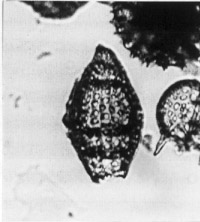 Eucyrtidium
inflatum Kling
Eucyrtidium
inflatum Kling Eucyrtidium
inflatum Kling
Eucyrtidium
inflatum KlingEucyrtidium inflatum Kling, 1973, p.636, pl.11, figs.7-8, pl.15, figs.7-10
Cephalis subspherical to hemispherical, with sparse circular pores; bears a tiny apical spine that is inconspicuous or lacking in many specimens. Collar stricture indistinct. Thorax slightly inflated conical, moderate rough-surfaced, with longitudinal ribs on lower part separating longitudinal rows of circular pores. Lumbar stricture distinct. Abdomen and one or more postabdominal segments define characteristic inflated, truncate fusiform section of the test without externally expressed strictures. Pores in this section are circular, arranged in strict longitudinal rows separated by distinct, sharp-crested ridges. Widest part of shell in abdomen or spanning division between abdomen and fourth segment. In some specimens, gentle stricture separates symmetrical fusiform section from fragmentary lower chamber (Kling, 1973).
Based on 15 specimens. Maximum width 80-94 µm, length of cephalis to distal end of thorax 36-44 µm, to end of abdomen 90-100 µm, to end of fourth segment 120-136 µm; abdominal pore minimum 2-4 µm, maximum 5-9 µm, average close to maximum (Kling, 1973).
This species differs from E. calvertense in the inflated fusiform section of the shell and relatively large and widely spaced pores. E. calvertense is seldom widest at the abdomen, as E. inflatum nearly always is. E. matuyamai is larger and inflated at more distal segments (Kling, 1973).
The morphotypic last appearance of this middle- and high-latitude species lies within the Diartus petterssoni Zone. Its morphotypic first appearance is in the middle Miocene.
E. inflatum evolves from E. calvertense in the middle (?) Miocene and reaches extinction without apparent descendants in the upper (?) Miocene (Kling, 1973).